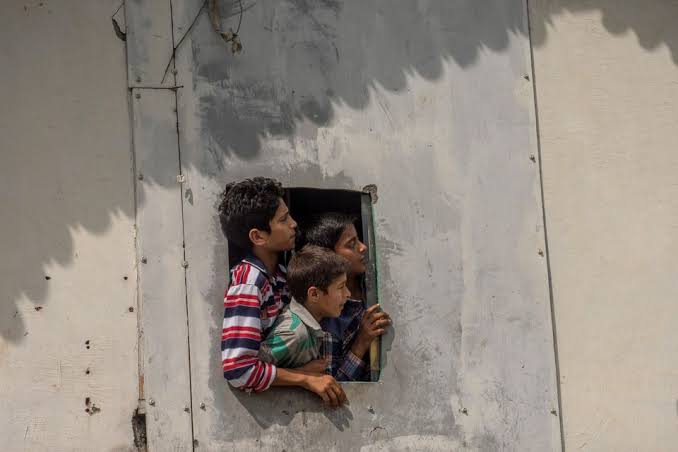Affidavit reveals JJ Committee merely parroted DGP’s line denying detention of minors

Kashmiri children look towards clashes between protesters and security forces on August 30, 2019. Image: Getty Images
Enakshi Ganguly, a child rights activist who had moved Supreme Court demanding protection for children and teenagers allegedly detained by security forces in wake of the abrogation of Article 370 in the region, has now punched holes in the Juvenile Justice Committee’s (JJC) report on the matter to the SC.
In September this year, the Supreme Court had directed the Jammu and Kashmir High Court’s Juvenile Justice Committee to conduct an inquiry into the allegations. On September 26, the JJ Committee submitted its report giving a virtual clean chit to security forces. But now, Ganguly has made a comprehensive analysis of the report and discovered that the JJC has merely reproduced the submission of the Director General of the Police.
In her rebuttal of the report Ganguly says, “… the Report of the Juvenile Justice Committee that relies only on the response of the selfsame party (without having heard any other stakeholder), and without having applied its mind to it does not serve the purpose of the exercise.”Reliance on DGP’s reportThe JJC in its report to the SC says that upon being communicated the apex courts order, it convened a meeting on September 23, and “resolved to ascertain facts from the concerned state agencies as to the assertions and allegations made in the writ petition in question, based on media reports.”
In its submission before the SC, the JJC says that the Director General of Police has refuted the media reports alleging detention of children. It quotes the DGP’s submission as follows, “It is pertinent to state that no child kept or taken into illegal detention by the Police authorities as strict adherence is placed on the provisions of Juvenile Justice (Care and Protection of Children) Act.”
The JJC report then reproduces large chunk’s the DGP’s report where he takes on each allegation of detention and/or violence against children as “facts having been imagined from thin air”, “generated with the intention to malign the police”, or “to create the story which may have element of sensationalism.
To this Ganguly argues in her response affidavit saying, “That equally important, there are numerous unconnected and independent reports from fact-finding teams of concerned citizens and activists, mainstream newspaper, both domestic and international, video reports etc. which strongly allege instances of excesses against children. They have been coming out consistently and are. available in the· public domain. It is submitted that their summary dismissal as ‘false’, ‘motivated lies’ would be to our own detriment and to the detriment of our Constitutional morality.”
Ganguly also has another key question for the DGP. She asks, “A bald assertion has been made in the DGP’s Report at Page 25 to the effect that ‘ Child welfare committees’ are effectively working. In Fact, a good barometer of their effective working would be reduced encounter of security personnel with children in need of care and protection, for it should ideally be the task of ewes and Childlines to help and counsel children. It would be important to know how the Childlines established in Srinagar, Budgam and Anantnag are being run. How may calls have they received/ responded to after 5 August 2019?”
She also adds, “It is surprising and unfortunate that the DGP’s report should presume to comment on the motives of the Petitioners. The unsubstantiated comments are defamatory, but more critically they seem to dismiss the culture of judicial review of executive action, and of upholding constitutional rights.”
Bail applications and Habeas Corpus Petitions
In its submission before the SC, the JJC had also stated that it resolved to obtain data about “bail applications or Habeas Corpus Petitions, if any, moved on behalf of Juveniles or where it was claimed that the arrested person(s) or detainees were juveniles, and the process undertaken therein.”
In this regard Ganguly says, “That two excellent sources of independent verification are also identified in the aforesaid Minutes: Habeas Corpus Petitions filed on behalf of minors and bail applications on behalf of minors filed before the subordinate Courts. However, it may be noted that since the Jammu and Kashmir Juvenile Justice (Care and Protection of Children) Act, 2013 (the Act) offers a separate mechanism for trial of children in conflict with law, it is the Juvenile Justice Board, under S. 13 that would grant or reject a Minor’s bail application. Thus, the Juvenile Justice Board may certainly be directed to furnish copies of bail applications, as also of the FlRs produced before them.”
She further adds, “Section 14 of the Act also directs that at the point of arrest, the special juvenile police unit must immediately inform the parents/guardian of the factum of the minor’s arrest and also give notice to them to be present before the Board, before which the child would appear. Thus the Juvenile police unit must have records of all such notices issued to Parents and corresponding appearances and Orders of the Board. The Committee may direct those to be placed on record.”
The entire JJC Report on Illegal Detention of Children in Kashmir may be read here.
Enakshi Ganguly’s affidavit in response to the report may be read here.
Feature Image: Pahari and Bakarwal children sit in front of a fallen tree for their photo. Lidderwat, Kashmir, India. Picture by Matt Brandon.
Related:
Investigate illegal detention of children in J&K: SC
SC seeks GOI’s reply to Kashmir petitions